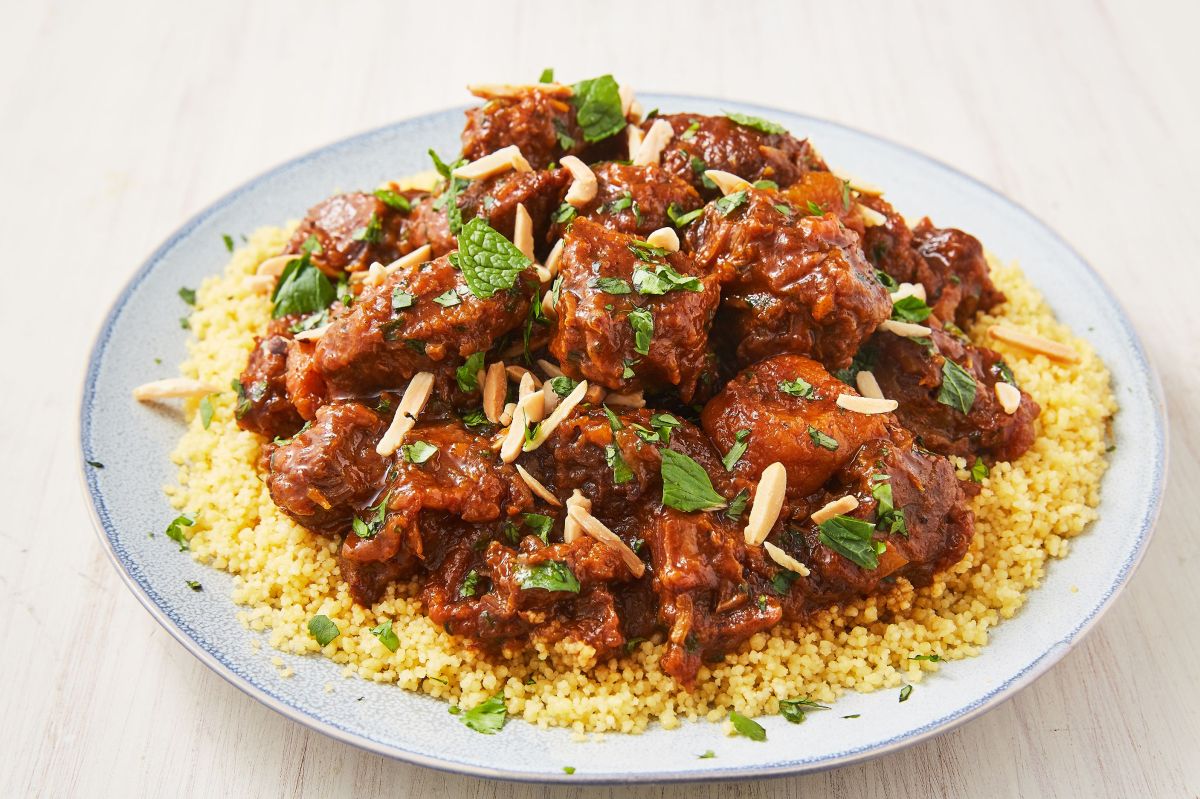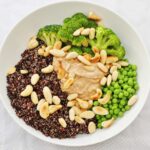Embark on a culinary journey through the vibrant and diverse landscape of Middle Eastern cuisine, where fragrant spices and fresh ingredients combine to create dishes bursting with flavor, all without relying on soy. This exploration unveils a world of naturally soy-free recipes, from classic staples to innovative adaptations, showcasing the region’s rich culinary heritage and its adaptability to dietary needs. We’ll delve into the unique flavor profiles of key spices, the nutritional benefits of common vegetables, and the traditional cooking techniques that elevate these dishes to unforgettable experiences.
Discover a treasure trove of soy-free recipes, including detailed step-by-step guides and insightful tips for adapting traditional dishes. We’ll explore regional variations, highlighting the cultural significance and historical context of some of the most beloved Middle Eastern meals. Whether you’re following a soy-free diet or simply seeking exciting new flavors, this guide will equip you with the knowledge and inspiration to create delicious and authentic Middle Eastern meals at home.
Popular Middle Eastern Soy-Free Ingredients
Middle Eastern cuisine boasts a vibrant tapestry of flavors, largely achieved without relying on soy. A cornerstone of this culinary tradition lies in the masterful use of fresh herbs, aromatic spices, and flavorful vegetables, all naturally soy-free and contributing to the region’s unique and delicious dishes. This section explores some of the key ingredients that make Middle Eastern food so distinctive.
Common Middle Eastern Soy-Free Ingredients
The following table highlights ten common ingredients found in many Middle Eastern dishes, all naturally free from soy:
| Ingredient | Ingredient | Ingredient | Ingredient |
|---|---|---|---|
| Olive Oil | Lentils (red, green, brown) | Chickpeas | Tahini (sesame seed paste) |
| Lemon Juice | Garlic | Onions | Tomatoes |
| Dates | Dried Apricots |
Key Middle Eastern Spices and Their Flavor Profiles
Five spices form the backbone of many Middle Eastern flavor profiles, each contributing a unique and complex dimension to the dishes.
- Cumin: Earthy and warm, with a slightly bitter note. It adds depth and complexity to stews, tagines, and roasted vegetables, lending a distinctive savory character.
- Turmeric: Known for its vibrant yellow-orange hue and slightly peppery, earthy flavor. It provides a warm, subtly bitter taste and contributes to the overall richness of the dish, often used in curries and rice dishes.
- Cinnamon: A sweet and warm spice, with notes of both spice and fruit. It adds a touch of sweetness and warmth to both sweet and savory dishes, particularly prevalent in baked goods and tagines.
- Cardamom: Possessing a unique aroma, cardamom offers a warm, sweet, and slightly pungent flavor. It is used in both sweet and savory dishes, adding a distinctive aromatic layer, frequently found in coffee, desserts, and stews.
- Sumac: A tart and lemony spice, sumac offers a bright, tangy counterpoint to richer flavors. It adds a vibrant acidity to salads, meats, and dips, providing a refreshing contrast.
Nutritional Benefits of Common Middle Eastern Vegetables
Many Middle Eastern vegetables are rich in essential nutrients, contributing to a healthy and balanced diet.
- Tomatoes: Excellent sources of lycopene, a powerful antioxidant linked to reduced risk of certain cancers and heart disease. They also provide vitamin C and potassium.
- Onions: Rich in quercetin, an antioxidant with anti-inflammatory properties. They also contain vitamin C, folate, and potassium, contributing to overall health and well-being.
- Cucumbers: Hydrating and low in calories, cucumbers provide a good source of vitamin K and potassium. They are often used in refreshing salads and dips.
Step-by-Step Recipe Creation
Crafting flavorful and aromatic lamb koftas is a journey into the heart of Middle Eastern cuisine. This recipe focuses on creating tender, juicy koftas bursting with a vibrant blend of spices, all while remaining completely soy-free. The process is straightforward, rewarding you with a dish that’s both visually appealing and intensely delicious.
Lamb Kofta Recipe: A Step-by-Step Guide
This recipe provides a detailed walkthrough, ensuring even novice cooks can achieve perfectly formed and flavorful lamb koftas. The visual descriptions will guide you through each stage, transforming simple ingredients into a culinary masterpiece.
- Preparing the Lamb: Begin by finely mincing 1 pound of high-quality ground lamb. The lamb should have a rich, deep red color, and a pleasant, slightly gamey aroma. Avoid overly lean lamb, as some fat content contributes to juiciness. Picture the lamb as a deep crimson cloud, finely textured and ready to be transformed.
- Creating the Aromatic Base: Finely chop 1 large onion, creating a delicate, almost translucent texture. Mince 2 cloves of garlic, their pungent aroma already filling the air. Add these, along with 1 teaspoon of ground cumin (its earthy scent warm and inviting), ½ teaspoon of ground coriander (offering a citrusy note), ¼ teaspoon of cayenne pepper (a fiery red powder adding a subtle heat), and a generous pinch of salt and freshly ground black pepper. The mixture should be a vibrant blend of colors and textures, a fragrant promise of the flavors to come.
- Incorporating the Ingredients: Gently combine the minced lamb with the aromatic base, using your hands to ensure even distribution. Avoid overmixing, as this can make the koftas tough. Imagine the mixture as a richly colored clay, carefully molded and shaped.
- Shaping the Koftas: Roll the lamb mixture into elongated ovals, about 2 inches long and ¾ inch in diameter. The koftas should be firm but not tightly packed. Their smooth, gently curved shapes are ready for their transformation in the heat.
- Cooking the Koftas: Heat a tablespoon of olive oil in a large skillet over medium-high heat. Once the oil shimmers, carefully place the koftas in the pan, leaving some space between each one. Cook for about 4-5 minutes per side, until they are nicely browned and cooked through. The koftas should be a beautiful golden brown, their surfaces slightly crisp, their interiors tender and juicy.
- Serving Suggestion: Serve the lamb koftas hot, accompanied by your favorite Middle Eastern sides such as hummus, pita bread, and a vibrant salad. The warm, savory koftas offer a delicious contrast to the cool, refreshing accompaniments.
Infographic Illustration of Lamb Kofta Preparation
Imagine a series of six vibrant squares, each depicting a step in the kofta-making process. The first shows a mound of finely minced, deep red lamb. The second displays the finely chopped onion and garlic, mingling with the warm brown spices. The third shows the gentle incorporation of the ingredients, a rich, textured blend. The fourth illustrates the perfectly formed, oval-shaped koftas. The fifth showcases the sizzling koftas in the skillet, turning a beautiful golden brown. The final square depicts the finished koftas, arranged artfully on a platter, ready to be served. Each square would be filled with rich, descriptive colors and textures, visually representing the transformation of ingredients into a finished dish.
Adjusting Spice Levels
To reduce the spice level, simply omit the cayenne pepper entirely. For a milder flavor, use a smaller quantity of cumin and coriander. For those who prefer a more intense heat, add a pinch or two of Aleppo pepper flakes for a fruity heat, or increase the cayenne pepper to ½ teaspoon or even more, depending on preference. Always taste and adjust to your personal preference.
Exploring Regional Variations

The Middle East, a vast and diverse region, boasts a rich culinary tapestry woven from centuries of tradition and cultural exchange. While sharing some common threads, regional variations in cuisine are significant, reflecting unique local ingredients, historical influences, and culinary practices. Examining these differences reveals a fascinating depth to Middle Eastern soy-free cooking.
| Region | Dish | Key Ingredients | Flavor Profile |
|---|---|---|---|
| Levant (Syria, Lebanon, Jordan, Palestine) | Mujadara | Lentils, rice, caramelized onions, spices (cumin, coriander) | Savory, slightly sweet, nutty, earthy |
| Egypt | Koshari | Rice, lentils, macaroni, chickpeas, tomato sauce, garlic vinegar, crispy fried onions | Savory, tangy, complex, with contrasting textures |
| Persian Gulf (Iran, Iraq, Kuwait, etc.) | Adas Polo (Lentil Rice) | Brown or green lentils, basmati rice, saffron, barberries, onions, herbs | Fragrant, slightly tart, rich, with a subtle sweetness from the barberries. |
Cultural Significance of Mujadara
Mujadara, a staple in Levantine cuisine, holds deep cultural and historical significance. Its simple yet satisfying combination of lentils and rice symbolizes abundance and prosperity. The dish is mentioned in ancient texts and is believed to have been consumed for centuries. Traditional preparation involves slowly caramelizing onions until deeply golden brown, imparting a rich sweetness that balances the earthiness of the lentils and the delicate texture of the rice. The spices used, often a blend of cumin and coriander, add warmth and complexity to the dish. Mujadara’s enduring popularity reflects its accessibility, nutritional value, and its symbolic representation of comfort and sustenance.
Comparison of Regional Dishes
The three dishes, while distinct, share some commonalities. All three utilize legumes (lentils or chickpeas) as a primary protein source, reflecting the importance of these ingredients in Middle Eastern diets. Rice is also a frequent component, providing a textural and caloric base. However, the flavor profiles diverge. Mujadara’s sweetness from caramelized onions contrasts with Koshari’s tangy vinegar and Adas Polo’s subtle tartness from barberries. The spice blends also vary, reflecting regional preferences and the availability of local herbs and spices. Koshari, with its layered components and contrasting textures, showcases a more complex approach than the simpler, yet equally satisfying, Mujadara and Adas Polo. Each dish represents a unique culinary expression of its region, highlighting the diversity within Middle Eastern cuisine.
From the aromatic warmth of spiced lamb koftas to the refreshing vibrancy of vegetable-based salads, Middle Eastern cuisine offers a boundless array of soy-free options brimming with flavor and cultural significance. This exploration has unveiled the versatility of traditional ingredients and techniques, demonstrating how easily these dishes can be adapted to suit dietary preferences without compromising taste or authenticity. We encourage you to experiment with the recipes provided, to explore the regional variations, and to discover the joy of creating flavorful and satisfying Middle Eastern meals that are both delicious and soy-free.
FAQ Insights
What are some common soy-free substitutes for soy sauce in Middle Eastern cooking?
Tamarind paste, pomegranate molasses, and a mixture of lemon juice, olive oil, and spices can all effectively replace soy sauce, adding unique flavor profiles.
Are all Middle Eastern dishes naturally soy-free?
No, while many traditional dishes are naturally soy-free, some modern interpretations or those influenced by other cuisines may contain soy ingredients. Always check recipes carefully.
Can I adjust the spice levels in these recipes?
Absolutely! Spice levels can be easily adjusted by adding or reducing the quantities of chili powder, paprika, or other spices according to your preference.
Where can I find authentic Middle Eastern ingredients?
Many Middle Eastern ingredients are available at specialty grocery stores, international markets, or online retailers. Check local stores for options.


